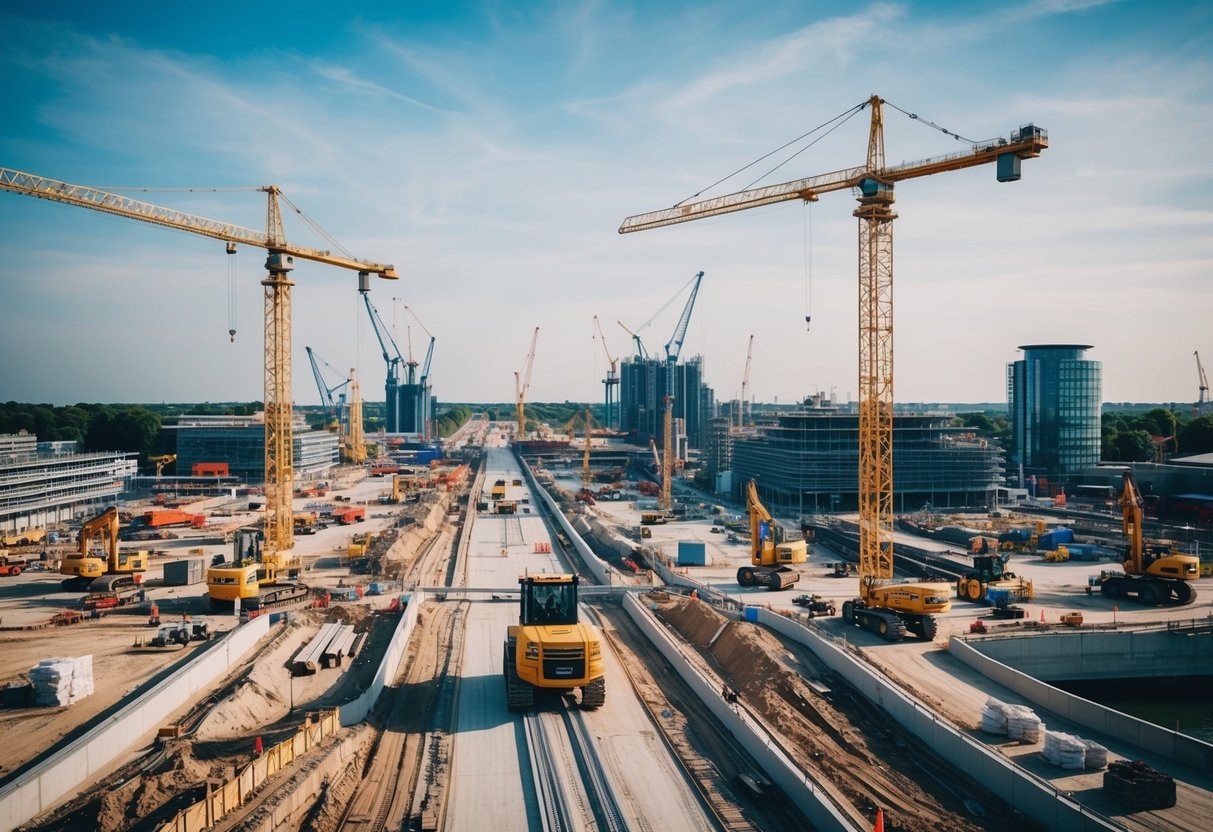Planned UK Infrastructure Spending for 2025: Government’s Key Investment Areas Revealed
The UK government has announced significant infrastructure investments for 2025, focusing on several key sectors to drive economic growth. National Highways has received £4.8 billion in interim funding for 2025/26, while £2.2 billion has been allocated for defence infrastructure and £2 billion for social and affordable housing. These investments form part of a broader plan that is expected to reach £700-775 billion in total infrastructure spending over the next decade.

To support these ambitious projects, the government plans to introduce a Planning and Infrastructure Bill in 2025. This legislation aims to streamline planning decisions for major economic projects and support the government’s goal of building 1.5 million homes in England. The bill will also include measures to accelerate approximately 150 planning decisions on projects deemed vital to the economy.
The 2025 Spring Statement has revealed a particular focus on grid infrastructure development to support the UK’s energy needs. While many in the infrastructure sector have welcomed these growth plans, some experts suggest the government could go further to maximise the economic benefits of these investments and address long-standing infrastructure challenges.
UK Government Infrastructure Spending Priorities for 2025

The UK government has established clear infrastructure spending priorities for 2025 as part of its 10-year national infrastructure strategy. These priorities focus on upgrading major economic infrastructure while maintaining fiscal responsibility amidst challenging economic conditions.
Overview of Major Infrastructure Investment
The UK government is prioritising investment in electricity networks and clean energy sources to support the country’s transition to net-zero emissions. Transport infrastructure remains a central focus, with significant allocations for roads and public transport links to improve connectivity across regions.
Water infrastructure has gained increased attention, particularly as climate change creates new challenges for water management and supply. The government has also highlighted the importance of social infrastructure, including schools and hospitals, as key components of its broader investment strategy.
Digital infrastructure expansion continues to be prioritised to support economic growth and reduce regional inequalities. The strategy aims to balance immediate infrastructure needs with long-term planning horizons.
Autumn Budget and Spending Review Insights
The upcoming Autumn Budget will set the framework for infrastructure spending in 2025, with four-year capital budgets expected to align with the 10-year strategy. Fiscal challenges are evident, with net debt projected to reach 82.9% of GDP in 2025-26 before rising to 83.5% in 2026-27.
Day-to-day spending cuts are anticipated, which may affect some infrastructure maintenance programmes. The government must balance these cuts with its commitment to large-scale infrastructure development.
The Spending Review 2025 will be crucial in establishing stability for infrastructure planning, helping to remove uncertainty that has historically hampered major projects. Priority projects will likely be those that demonstrate clear economic returns and support the government’s broader policy objectives.
Role of the Chancellor and HM Treasury
Chancellor Rachel Reeves faces the challenge of maintaining infrastructure investment while adhering to strict fiscal rules. HM Treasury will play a central role in evaluating infrastructure proposals based on value for money, economic impact and alignment with national priorities.
The Treasury’s approach to infrastructure will likely emphasise projects that can attract private investment alongside public funding. This partnership model aims to maximise the impact of limited government resources.
Infrastructure bonds and innovative financing mechanisms may be introduced to fund major projects without significantly increasing government debt. The Chancellor has indicated that infrastructure decisions will be guided by economic evidence rather than political considerations, marking a potential shift in approach.
Key Infrastructure Projects and Delivery Strategies

The UK government has outlined several major infrastructure projects and implementation strategies for 2025 and beyond. These initiatives aim to strengthen the nation’s social, economic and housing infrastructure while ensuring efficient delivery and value for money.
Planned Major Infrastructure Schemes
The government’s 10-year infrastructure strategy includes significant transport investments with £4.8 billion allocated to National Highways for 2025/26 as interim funding. This supports ongoing road maintenance and development whilst the comprehensive strategy is finalised.
Railway improvements remain a priority, with continued investment in major lines and regional connectivity projects. Several urban tram systems will benefit from a new 10-year investment pipeline that provides long-term planning certainty.
Social infrastructure receives substantial attention with funding for new hospitals, healthcare facilities and school buildings. These projects address critical capacity needs and replace ageing facilities.
Housing infrastructure forms another key pillar, with investments in utilities, transport links and community facilities to support new residential developments across high-growth areas.
Infrastructure Delivery and Project Planning
The government has restructured its approach by bringing infrastructure strategy and delivery under one roof. This consolidation aims to improve coordination between planning and implementation phases.
Project planning now requires more robust business cases with clearer alignment to national strategic objectives. The Office for Budget Responsibility plays a crucial role in assessing the fiscal implications of major infrastructure commitments.
Key delivery improvements include:
- Enhanced stakeholder consultation processes
- Earlier engagement with industry partners
- More realistic project timelines and cost estimates
- Streamlined planning and approval pathways
The new approach emphasises skills development within delivery teams and greater standardisation where appropriate to reduce costs and accelerate delivery timeframes.
Monitoring Value for Money in Project Implementation
Value for money has become central to infrastructure delivery with strengthened monitoring frameworks being introduced. Each major project now faces regular assessment against established benchmarks and delivery targets.
The government has implemented enhanced reporting requirements with quarterly progress updates for significant schemes. This transparency helps identify potential issues earlier and enables more timely interventions.
Cost control measures include:
- Improved procurement strategies
- Stronger contract management
- Technology adoption to increase efficiency
- Competitive tendering processes
Independent reviews at critical project stages provide additional scrutiny. These “gateway reviews” ensure projects remain aligned with strategic objectives and maintain their value proposition throughout implementation.
Public-private partnership models have been refined to better share risk and improve outcomes while protecting taxpayer interests.
Housing and Urban Development Initiatives

The UK government has outlined ambitious plans to address housing shortages through targeted initiatives. These programmes aim to deliver 1.5 million new homes during the current parliamentary term while focusing on affordability and sustainability.
Affordable Homes Programme Expansion
The Affordable Homes Programme has received significant funding increases for 2025, with allocations focusing on areas with acute housing shortages. The government has earmarked £7.2 billion to support the construction of affordable housing units across the UK.
Local authorities have been granted additional powers to accelerate development on brownfield sites, particularly in urban areas where demand exceeds supply. These measures are expected to deliver approximately 230,000 affordable homes by 2027.
The programme includes specific quotas for social rent properties, addressing concerns about the lack of genuinely affordable options for lower-income households. First-time buyer schemes have also been enhanced with improved shared ownership models and deposit assistance programmes.
Boosting Housebuilding Activity
Recent reforms in the Planning and Infrastructure Bill aim to streamline planning processes and fast-track major housing developments. The government expects these changes to help build over 170,000 homes annually, contributing to a forecast of 1.3 million new homes across the UK within five years.
Local planning authorities will receive additional resources to process applications more quickly. The bill supports fast-tracking of 150 planning decisions on major economic infrastructure projects deemed vital for growth.
Incentives for private developers include tax breaks for projects meeting specific delivery timelines and density requirements. These measures aim to address the persistent gap between planning permissions granted and homes actually built.
Sustainability in New Homes
All new housing developments must now adhere to stricter environmental standards, with emphasis on energy efficiency and carbon reduction. New building regulations require homes to produce 75% less carbon emissions compared to current standards.
The Future Homes Standard will be fully implemented in 2025, requiring new builds to feature low-carbon heating systems and high levels of energy efficiency. Grant funding is available for developers incorporating innovative green technologies.
Retrofit demand for existing properties has been addressed through an expanded Green Homes Grant scheme, providing homeowners with subsidies for insulation improvements and renewable energy installations. These measures align with the UK’s broader commitment to achieving net-zero emissions by 2050.
Sustainable Energy and Environmental Commitments

The UK government has outlined ambitious plans for sustainable energy infrastructure in 2025. These commitments aim to ensure that clean sources produce at least 95% of Great Britain’s energy generation by 2030, with significant funding already allocated for development projects.
Renewable Energy Infrastructure Projects
The government has earmarked £100 million in capital funding specifically for clean energy project development in 2025-2026. This investment is designed to attract an additional £21.9 billion in private funding, creating a substantial boost to renewable infrastructure capacity.
New planning reforms are set to accelerate delivery of clean energy projects by at least one year on average. This streamlined approach aims to reduce bureaucratic hurdles while maintaining environmental standards.
The revised National Policy Statement establishes clear pathways for energy infrastructure, prioritising wind, solar and other renewable technologies. These projects will be strategically located to maximise generation capacity while minimising environmental impact.
Offshore wind continues to be a cornerstone of UK renewable strategy, with several major North Sea projects receiving approval for construction beginning in 2025.
Net Zero Targets and Decarbonisation
The government remains committed to achieving net zero carbon emissions, with infrastructure planning directly tied to these goals. Decarbonisation efforts focus on both energy production and consumption sides of the equation.
The Planning and Infrastructure Bill (April 2025) specifically prioritises low-carbon infrastructure development. This includes EV charging networks and sustainable transport systems necessary for reducing transport emissions.
Industrial decarbonisation clusters are being developed in key regions, with funding allocated for carbon capture and storage technologies. These projects aim to help emissions-intensive industries transition to cleaner operations.
Public buildings are being retrofitted with enhanced energy monitoring systems to reduce consumption and set examples for the private sector.
Retrofitting and Energy-Efficient Buildings
The government’s Warm Homes Plan continues to gain momentum with additional funding for 2025. This programme targets the UK’s older housing stock, which accounts for a significant portion of energy consumption nationwide.
Retrofitting projects are focusing on improved insulation, efficient heating systems, and smart energy controls. These upgrades are expected to reduce average household energy bills by 20-30%.
New building regulations instituted in early 2025 require higher energy efficiency standards for all new construction. These standards emphasise the use of eco-friendly materials and greener construction methods.
Local authorities have received dedicated funding to identify and upgrade the most energy-inefficient properties in their regions. Priority is given to low-income households and areas with poor energy infrastructure.
Digital and Technological Transformation of Infrastructure
The UK government has committed to investing £8 billion in digital, data and technology transformation by 2025. This substantial funding aims to modernise outdated systems and improve efficiency across infrastructure sectors.
Digital Economy and Tech Sector Investment
The UK’s digital economy stands to benefit significantly from the planned 2025 infrastructure spending. The government has allocated dedicated funds to boost digital transformation across public services and infrastructure networks.
TechUK, the UK’s technology trade association, has welcomed this investment as a critical step towards maintaining Britain’s competitive edge in global tech markets. The funding will target areas such as artificial intelligence, data analytics, and cloud computing infrastructure.
Private sector involvement is expected to amplify the impact of government spending. The initial public investment aims to attract nearly £22 billion in additional private funding, creating a substantial pool of resources for technological advancement.
Regional tech hubs outside London will receive targeted support to ensure the benefits of digital investment are felt across the country.
Construction Sector Digitisation
Construction is undergoing a digital revolution with significant investment planned for 2025. The UK government has earmarked funds specifically for digitising traditional construction processes.
Key initiatives include:
- Implementation of advanced monitoring systems
- Adoption of automated construction technologies
- Development of digital twins for major infrastructure projects
- Training programmes for digital upskilling of the workforce
These investments aim to increase productivity in a sector traditionally slow to adopt new technologies. Digital tools are expected to reduce construction costs by up to 20% while improving project delivery timelines.
The £3.25 billion Transformation Fund will partially support these digitisation efforts, focusing on projects that demonstrate innovative approaches to infrastructure development.
Innovation and Building Information Modelling
Building Information Modelling (BIM) continues to be a cornerstone of the UK’s infrastructure digitisation strategy. The 2025 spending plan reinforces the mandatory use of BIM Level 2 for all publicly funded projects.
Government funding will support the development of advanced BIM capabilities, including:
- Integration with Internet of Things (IoT) sensors
- Enhanced data analytics for predictive maintenance
- Real-time monitoring of infrastructure performance
- Sustainability analysis and carbon footprint reduction
Predictive maintenance technologies will receive particular attention, with funding allocated to develop AI-powered systems that can identify potential failures before they occur. These systems are expected to reduce maintenance costs by 15-30% while extending infrastructure lifespan.
Innovation hubs at major universities will receive funding to research next-generation infrastructure technologies, ensuring the UK remains at the forefront of digital construction methods.
Regulatory and Planning Reforms
The UK government is implementing significant changes to streamline infrastructure development and housing projects. These reforms aim to reduce approval times for major projects while maintaining necessary safety standards.
Planning and Infrastructure Bill Developments
The Planning and Infrastructure Bill, introduced in 2024-25, represents a cornerstone of the government’s strategy to accelerate infrastructure delivery. This legislation aims to halve approval times for nationally significant infrastructure projects by streamlining the existing processes under the Planning Act 2008.
The bill supports the government’s ambitious target to build 1.5 million homes by making it easier to develop essential supporting infrastructure like roads, reservoirs and energy facilities. A key goal is to slash approximately one year from the typical infrastructure delivery timeline.
Projects classified as nationally significant infrastructure will face revised requirements. The bill introduces specific changes to how these projects are assessed and approved, creating a more efficient pathway for critical developments without compromising on quality or safety standards.
Revised Building Regulations and Safety Standards
The Building Safety Act has introduced comprehensive changes to construction regulations across the UK. These revisions establish clearer accountability for building safety throughout the entire lifecycle of developments, from initial design through construction to occupation.
Key updates include:
- Stricter fire safety requirements
- New competency standards for building professionals
- Enhanced testing protocols for construction materials
- More rigorous inspection regimes during and after construction
These regulatory changes respond directly to safety concerns identified in recent years. The focus remains on creating buildings that are not only developed more quickly but also constructed to higher safety standards.
Impact of Regulatory Changes on Project Delivery
The regulatory reforms are expected to produce measurable improvements in project delivery timelines. Experts predict the Planning and Infrastructure Bill could reduce approval processes by up to 50% for major projects, including wind farms and power installations.
These changes shift resources toward actual development rather than administrative processes. Developers report the streamlined approach will allow them to better forecast project timelines and costs, reducing financial uncertainties that previously delayed investments.
Local communities will benefit from faster delivery of critical services and infrastructure. However, some planning professionals express concern about balancing speed with proper community consultation.
The government has established new oversight mechanisms to ensure the accelerated processes don’t compromise quality. These include enhanced monitoring systems and regular reviews of outcomes to assess whether the reforms are achieving their intended goals.
Financing, Investment, and Economic Impact
The UK’s infrastructure spending plan for 2025 relies on a complex mix of funding sources and aims to boost economic growth while managing public debt. Government has committed to increased capital spending as outlined in the Spring Statement 2025, focusing on strategic investments that can deliver long-term economic benefits.
Public and Private Investment Partnerships
National Highways has secured £4.8 billion in interim funding for 2025/26, demonstrating the government’s commitment to transport infrastructure. This represents part of a broader investment strategy that combines public funding with private sector capital.
The government has created new frameworks to encourage private investment in major infrastructure projects. These partnerships aim to spread financial risk while accelerating project delivery timelines.
Several commercial construction firms have already committed to joint ventures, particularly in renewable energy and digital infrastructure sectors. These collaborations are expected to increase construction output by approximately 3.8% in 2025/26.
Local authorities are being granted new powers to enter into regional development agreements with private investors, creating localised infrastructure improvement zones with streamlined planning processes.
Economic Growth and Living Standards
Infrastructure investments are projected to boost economic growth by 1.2% over the next three years. The Office for Budget Responsibility forecasts that real earnings will grow by 1.4% in 2025, though this growth is expected to stagnate in 2026 and 2027.
Major transport and energy projects are creating thousands of skilled jobs across the UK. In areas with significant infrastructure development, property values have increased by an average of 7%, though this has raised concerns about affordability.
Digital infrastructure improvements are expected to increase productivity in previously underserved regions. The government has promised that 95% of homes will have access to gigabit-capable broadband by 2026.
New energy infrastructure aims to reduce household utility costs by 12% over five years, directly improving living standards particularly for lower-income households.
Managing Public Debt and Spending Cuts
The ambitious infrastructure programme comes amid concerns about rising public debt levels. The Treasury has implemented a fiscal rule that capital investment must demonstrate clear economic returns to justify borrowing.
Defence spending increases to £6.4 billion by 2027 will be partially funded through cuts to the overseas aid budget. This represents a significant reallocation of resources toward domestic priorities.
Several non-essential government departments face budget reductions of 5-8% to help finance critical infrastructure. The government argues these cuts will not affect frontline services.
The Treasury has introduced new debt management strategies, including longer-term bonds specifically designed to fund infrastructure projects. These have attracted significant interest from pension funds seeking stable long-term returns.
Skills, Workforce Development, and Industry Challenges
The UK construction sector faces significant labour shortages in 2025, with rising wage demands and demographic challenges threatening project delivery. These pressures coincide with ambitious infrastructure plans requiring new skills and innovative approaches to workforce development.
Construction Sector Workforce and Training Initiatives
The UK construction sector currently experiences a critical skills shortage that threatens to undermine infrastructure delivery targets. As of spring 2025, nearly 15% of skilled positions remain unfilled, with civil engineering roles particularly affected.
Government and industry have responded with targeted training programmes. The Construction Skills Fund has expanded to £250 million, supporting 35,000 new apprenticeships by December 2025.
Several major contractors have established regional training hubs that provide practical skills development. These centres focus on modern methods of construction (MMC) and digital engineering to bridge the skills gap.
Demographic challenges remain significant, with 22% of the current workforce expected to retire within five years. Industry leaders are working to attract more diverse talent through school outreach programmes and career transition pathways.
Driving Innovation Through Skills England
Skills England, launched in January 2025, coordinates nationwide construction training initiatives. With a £180 million budget, the organisation aims to standardise qualifications and create clear career pathways.
Their digital skills programme has already trained 8,500 workers in BIM technologies and digital project management. This addresses the growing technical requirements of modern infrastructure projects.
Skills England has partnered with 12 universities to develop specialised civil engineering courses focused on sustainable construction methods and resilient infrastructure. These programmes incorporate industry placements to ensure graduates possess practical knowledge.
The organisation’s Construction Career Passport scheme simplifies verification of qualifications across projects, reducing administrative barriers and increasing workforce mobility between sites.
Supply Chain Sustainability and Industry Collaboration
The Supply Chain Sustainability School has expanded its remit in 2025 to address both environmental and workforce resilience. Its membership now includes over 75% of tier-one contractors in the UK.
Collaborative procurement models are gaining traction, with shared apprenticeship schemes allowing smaller firms to participate in training programmes previously accessible only to large contractors.
Industry leaders have established regional skills alliances in five high-demand areas, including Greater Manchester and the West Midlands. These partnerships coordinate training resources to meet specific regional infrastructure needs.
Digital platforms now connect qualified workers with project opportunities across the country, helping to address localised skills shortages. This approach has reduced project delays by approximately 18% on major infrastructure schemes.
Looking for a Career Change?
Check out our latest Job Listings

